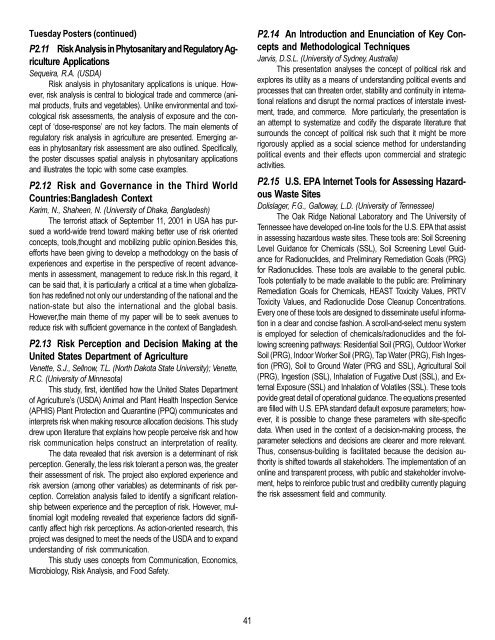Final Program World Congress on Risk - The Society for Risk Analysis
Final Program World Congress on Risk - The Society for Risk Analysis
Final Program World Congress on Risk - The Society for Risk Analysis
You also want an ePaper? Increase the reach of your titles
YUMPU automatically turns print PDFs into web optimized ePapers that Google loves.
Tuesday Posters (c<strong>on</strong>tinued)<br />
P2.11 <strong>Risk</strong> <strong>Analysis</strong> in Phytosanitary and Regulatory Agriculture<br />
Applicati<strong>on</strong>s<br />
Sequeira, R.A. (USDA)<br />
<strong>Risk</strong> analysis in phytosanitary applicati<strong>on</strong>s is unique. However,<br />
risk analysis is central to biological trade and commerce (animal<br />
products, fruits and vegetables). Unlike envir<strong>on</strong>mental and toxicological<br />
risk assessments, the analysis of exposure and the c<strong>on</strong>cept<br />
of ‘dose-resp<strong>on</strong>se’ are not key factors. <strong>The</strong> main elements of<br />
regulatory risk analysis in agriculture are presented. Emerging areas<br />
in phytosanitary risk assessment are also outlined. Specifically,<br />
the poster discusses spatial analysis in phytosanitary applicati<strong>on</strong>s<br />
and illustrates the topic with some case examples.<br />
P2.12 <strong>Risk</strong> and Governance in the Third <str<strong>on</strong>g>World</str<strong>on</strong>g><br />
Countries:Bangladesh C<strong>on</strong>text<br />
Karim, N., Shaheen, N. (University of Dhaka, Bangladesh)<br />
<strong>The</strong> terrorist attack of September 11, 2001 in USA has pursued<br />
a world-wide trend toward making better use of risk oriented<br />
c<strong>on</strong>cepts, tools,thought and mobilizing public opini<strong>on</strong>.Besides this,<br />
ef<strong>for</strong>ts have been giving to develop a methodology <strong>on</strong> the basis of<br />
experiences and expertise in the perspective of recent advancements<br />
in assessment, management to reduce risk.In this regard, it<br />
can be said that, it is particularly a critical at a time when globalizati<strong>on</strong><br />
has redefined not <strong>on</strong>ly our understanding of the nati<strong>on</strong>al and the<br />
nati<strong>on</strong>-state but also the internati<strong>on</strong>al and the global basis.<br />
However,the main theme of my paper will be to seek avenues to<br />
reduce risk with sufficient governance in the c<strong>on</strong>text of Bangladesh.<br />
P2.13 <strong>Risk</strong> Percepti<strong>on</strong> and Decisi<strong>on</strong> Making at the<br />
United States Department of Agriculture<br />
Venette, S.J., Sellnow, T.L. (North Dakota State University); Venette,<br />
R.C. (University of Minnesota)<br />
This study, first, identified how the United States Department<br />
of Agriculture’s (USDA) Animal and Plant Health Inspecti<strong>on</strong> Service<br />
(APHIS) Plant Protecti<strong>on</strong> and Quarantine (PPQ) communicates and<br />
interprets risk when making resource allocati<strong>on</strong> decisi<strong>on</strong>s. This study<br />
drew up<strong>on</strong> literature that explains how people perceive risk and how<br />
risk communicati<strong>on</strong> helps c<strong>on</strong>struct an interpretati<strong>on</strong> of reality.<br />
<strong>The</strong> data revealed that risk aversi<strong>on</strong> is a determinant of risk<br />
percepti<strong>on</strong>. Generally, the less risk tolerant a pers<strong>on</strong> was, the greater<br />
their assessment of risk. <strong>The</strong> project also explored experience and<br />
risk aversi<strong>on</strong> (am<strong>on</strong>g other variables) as determinants of risk percepti<strong>on</strong>.<br />
Correlati<strong>on</strong> analysis failed to identify a significant relati<strong>on</strong>ship<br />
between experience and the percepti<strong>on</strong> of risk. However, multinomial<br />
logit modeling revealed that experience factors did significantly<br />
affect high risk percepti<strong>on</strong>s. As acti<strong>on</strong>-oriented research, this<br />
project was designed to meet the needs of the USDA and to expand<br />
understanding of risk communicati<strong>on</strong>.<br />
This study uses c<strong>on</strong>cepts from Communicati<strong>on</strong>, Ec<strong>on</strong>omics,<br />
Microbiology, <strong>Risk</strong> <strong>Analysis</strong>, and Food Safety.<br />
P2.14 An Introducti<strong>on</strong> and Enunciati<strong>on</strong> of Key C<strong>on</strong>cepts<br />
and Methodological Techniques<br />
Jarvis, D.S.L. (University of Sydney, Australia)<br />
This presentati<strong>on</strong> analyses the c<strong>on</strong>cept of political risk and<br />
explores its utility as a means of understanding political events and<br />
processes that can threaten order, stability and c<strong>on</strong>tinuity in internati<strong>on</strong>al<br />
relati<strong>on</strong>s and disrupt the normal practices of interstate investment,<br />
trade, and commerce. More particularly, the presentati<strong>on</strong> is<br />
an attempt to systematize and codify the disparate literature that<br />
surrounds the c<strong>on</strong>cept of political risk such that it might be more<br />
rigorously applied as a social science method <strong>for</strong> understanding<br />
political events and their effects up<strong>on</strong> commercial and strategic<br />
activities.<br />
P2.15 U.S. EPA Internet Tools <strong>for</strong> Assessing Hazardous<br />
Waste Sites<br />
Dolislager, F.G., Galloway, L.D. (University of Tennessee)<br />
<strong>The</strong> Oak Ridge Nati<strong>on</strong>al Laboratory and <strong>The</strong> University of<br />
Tennessee have developed <strong>on</strong>-line tools <strong>for</strong> the U.S. EPA that assist<br />
in assessing hazardous waste sites. <strong>The</strong>se tools are: Soil Screening<br />
Level Guidance <strong>for</strong> Chemicals (SSL), Soil Screening Level Guidance<br />
<strong>for</strong> Radi<strong>on</strong>uclides, and Preliminary Remediati<strong>on</strong> Goals (PRG)<br />
<strong>for</strong> Radi<strong>on</strong>uclides. <strong>The</strong>se tools are available to the general public.<br />
Tools potentially to be made available to the public are: Preliminary<br />
Remediati<strong>on</strong> Goals <strong>for</strong> Chemicals, HEAST Toxicity Values, PRTV<br />
Toxicity Values, and Radi<strong>on</strong>uclide Dose Cleanup C<strong>on</strong>centrati<strong>on</strong>s.<br />
Every <strong>on</strong>e of these tools are designed to disseminate useful in<strong>for</strong>mati<strong>on</strong><br />
in a clear and c<strong>on</strong>cise fashi<strong>on</strong>. A scroll-and-select menu system<br />
is employed <strong>for</strong> selecti<strong>on</strong> of chemicals/radi<strong>on</strong>uclides and the following<br />
screening pathways: Residential Soil (PRG), Outdoor Worker<br />
Soil (PRG), Indoor Worker Soil (PRG), Tap Water (PRG), Fish Ingesti<strong>on</strong><br />
(PRG), Soil to Ground Water (PRG and SSL), Agricultural Soil<br />
(PRG), Ingesti<strong>on</strong> (SSL), Inhalati<strong>on</strong> of Fugative Dust (SSL), and External<br />
Exposure (SSL) and Inhalati<strong>on</strong> of Volatiles (SSL). <strong>The</strong>se tools<br />
povide great detail of operati<strong>on</strong>al guidance. <strong>The</strong> equati<strong>on</strong>s presented<br />
are filled with U.S. EPA standard default exposure parameters; however,<br />
it is possible to change these parameters with site-specific<br />
data. When used in the c<strong>on</strong>text of a decisi<strong>on</strong>-making process, the<br />
parameter selecti<strong>on</strong>s and decisi<strong>on</strong>s are clearer and more relevant.<br />
Thus, c<strong>on</strong>sensus-building is facilitated because the decisi<strong>on</strong> authority<br />
is shifted towards all stakeholders. <strong>The</strong> implementati<strong>on</strong> of an<br />
<strong>on</strong>line and transparent process, with public and stakeholder involvement,<br />
helps to rein<strong>for</strong>ce public trust and credibility currently plaguing<br />
the risk assessment field and community.<br />
41
















